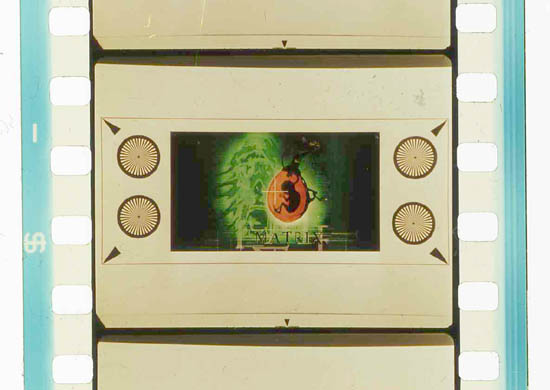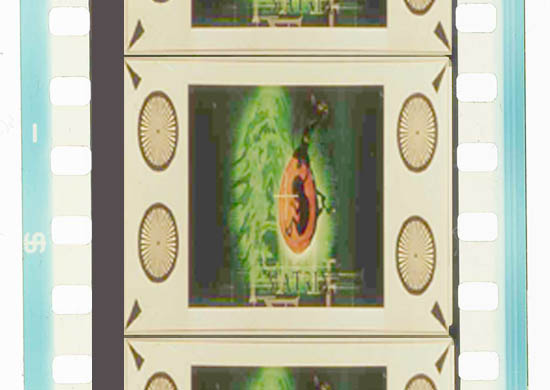|
|
This topic comprises 3 pages: 1 2 3
|
|
Author
|
Topic: Super 35 explained
|
|
|
|
|
|
|
|
|
Monte L Fullmer
Film God

Posts: 8367
From: Nampa, Idaho, USA
Registered: Nov 2004
|
 posted 12-20-2004 02:55 AM
posted 12-20-2004 02:55 AM




Course, wasn't S-35 basically created for shooting a wide screen movie and not to lose the "depth of field" with using regular F/stop lenses, which was "the curse" with anamorphic lenses on cameras-anamorphic lenses not being able to capture the "depth of field" as with the regular(flat)lenses?
BTW: Steve, I check out your site with that screening room, and also the picts of the screening room with those 12, small JBL surrounds around the back half of the auditorium. Very impressive with all of this.
Question may I ask: would you say that if one was to design a home theatre configuration, would this be the most effective way in presenting surround sound in a confined space, as such as the size of this screening room, to not to "localized the surround information", yet carry the larger speakers behind screen, as so mentioned?
thx-Monte
| IP: Logged
|
|
|
|
John Pytlak
Film God

Posts: 9987
From: Rochester, NY 14650-1922
Registered: Jan 2000
|
 posted 12-20-2004 08:44 AM
posted 12-20-2004 08:44 AM





Steve: Nice explanation of Super-35. ![[Cool]](cool.gif)
If a Digital Intermediate is going to be used for color manipulation or digital effects anyway, shooting 1.85:1 using the wider Super-35 negative area makes lots of sense. Since the area on the camera negative that ends up on the screen is 0.945 x 0.511 inches, instead of 0.825 x 0.446 inches, the graininess should be reduced. The added sharpness would likely require a 4K scan to fully appreciate.
http://www.cinesite.com/?1221&0&3821
quote:
2K, 4K or 6K scanning (35mm)and Datacine scanning (16mm) for Look Creation, Color Correction and Digital Answer Printing for all or a portion of Feature Films, Long Form Broadcast, Titles & Trailers. Mastering to all formats --Film, Video (HD, SD, DVD), and Digital Cinema.
THE PROCESS
With Cinesite's Digital Intermediate process, the interactive color-grading and image processing tools of the telecine suite are now available at the film level. The Digital Intermediate process starts with the digitizing (scanning) of select takes or the entire original negative @ 2K, 4K or 6K resolution. Utilizing a Northlight or Kodak's Lightning Scanners, film is digitized to 2K data files and loaded to a Spectre Virtual Datacine for more flexible realtime manipulation.
DIGITAL COLORIST
A skilled colorist, working with the filmmaker, grades the shots using a Pandora MegaDef or DaVinci color corrector. In addition to the basic RGB color timing controls of the traditional film color timing process, the colorist has the full range of primary and secondary color correction, including the ability to selectively grade individual elements within a shot. The colorist also controls image processing capabilities such as contrast, sharpness and grain. Using "power windows" the colorist can isolate and manipulate very specific areas of the frame to achieve a desired look.
EDITING/TIME FRAME
In creating the Digital Intermediate, an edit decision list (EDL) can be imported from an off-line editor and utilized to digitally conform live action sequences, optical effects and visual effects.
The Digital Intermediate also compresses the traditional time frame required for answer printing and telecine video mastering. A single scan produces a digital master file for both film record-out and for all video formats. Once the film version is color corrected, the video and digital cinema versions will need a "trim" pass, but essentially they are color-corrected.
THE OUTPUTS - FILM, VIDEO, DIGITAL CINEMA
The Digital Intermediate can be output to three formats.
Film: The file can be recorded to a film inter-negative (IN) or inter-positive (IP) using Kodak Lightning laser film recorders. This IN and/or IP will have all the scene-to-scene color grading applied to it, thereby simplifying the answer printing operations in the film lab. And, by producing an IP, one film processing stage can be eliminated. Cinesite can also apply a digital squeeze on the output, thereby producing an anamorphic IP or IN for widescreen release. Our tests have shown that this digital squeeze is substantially sharper than the traditional process of producing an anamorphic IN with an optical printer. Additionally Super 16mm can be digitally "blown up" to 35mm, providing a less grainy image than an optical blow up.
Video: The Digital Intermediate is also the starting point for creating the various videotape masters for multi-format release. Starting with the digital files from the film version, the colorist can quickly re-grade and re-format the files for the various video formats (HD, SD, DVD). This delivery path from digital files to film results in time and money saved and produces a higher quality image due to minimal film handling. The process of scanning film to data also produces higher resolution video.
Digital Cinema: The Digital Intermediate can also be output to a third format - a 24P playback source suitable for digital projection.
END-TO-END SOLUTION
After the Digital Intermediate process is complete, Cinesite also offers digital archiving of the digital files (color-corrected or uncolor-corrected) and traditional film archiving for the film negative and other components. If the client prefers, this can all be accomplished at PRO-TEK, Kodak's state-or-the-art ANSI standard (45%BA Fahrenheit, 25% humidity) facility in Burbank.
SUMMARY
Digital Intermediate depends on more than the hardware and software tools that enable it. The quality and consistency of the output images require a thorough understanding of the end-to-end (film/video finishing) process involving carefully implemented calibration and quality control procedures. With Kodak's color science behind Cinesite's innovation and service, the feasibility of the Digital Intermediate process is now a reality and has been proven in the pioneering "look-driven" films O Brother, Where Art Thou? and Traffic onto today's current releases. Films seeking more conventional color timing or specific fine tuning, such as the ground breaking Conspiracy: The Meeting at Wansee (an HBO film shot on 16mm, scanned once, color-timed and output to both video and film) and Open Range, have also benefited from the Digital Intermediate process.
Every project is unique, yet requires the highest quality images demanded by the filmmaker's vision. With Cinesite's adaptability, experience and sophisticated technology, this goal can now be achieved.
http://www.laserpacific.com/news_highlights/news_rels_17.htm
quote:
Eastman Kodak Company announced today that it will concentrate all of its digital intermediate and other postproduction services for the motion picture and television industries in North America here at LaserPacific, a wholly owned subsidiary that the company acquired last October. LaserPacific CEO and President Emory Cohen says that the extraordinary capabilities at Cinesite Hollywood will be centralized as part of LaserPacific in their ongoing effort to focus on innovation and service for customers. The facility plans to open a fourth state-of-the-art digital intermediate suite in a theater environment before the end of the year.
"By focusing our resources, we are better positioned to provide our customers with the latest advances in hybrid and digital technologies and services," says Eric Rodli, president of Kodak's Entertainment Imaging division. "Our primary goal is to enable filmmakers to more easily and efficiently control and manipulate the images they create from pre-production through post-production. The evolution of digital intermediate technology will help ensure that audiences experience films the way they are intended to be seen on cinema and TV screens."
| IP: Logged
|
|
|
|
|
|
|
|
|
|
|
|
|
|
|
|
|
|
|
|
All times are Central (GMT -6:00)
|
This topic comprises 3 pages: 1 2 3
|
Powered by Infopop Corporation
UBB.classicTM
6.3.1.2
The Film-Tech Forums are designed for various members related to the cinema industry to express their opinions, viewpoints and testimonials on various products, services and events based upon speculation, personal knowledge and factual information through use, therefore all views represented here allow no liability upon the publishers of this web site and the owners of said views assume no liability for any ill will resulting from these postings. The posts made here are for educational as well as entertainment purposes and as such anyone viewing this portion of the website must accept these views as statements of the author of that opinion
and agrees to release the authors from any and all liability.
|

 Home
Home
 Products
Products
 Store
Store
 Forum
Forum
 Warehouse
Warehouse
 Contact Us
Contact Us




 Printer-friendly view of this topic
Printer-friendly view of this topic












![[Cool]](cool.gif)







